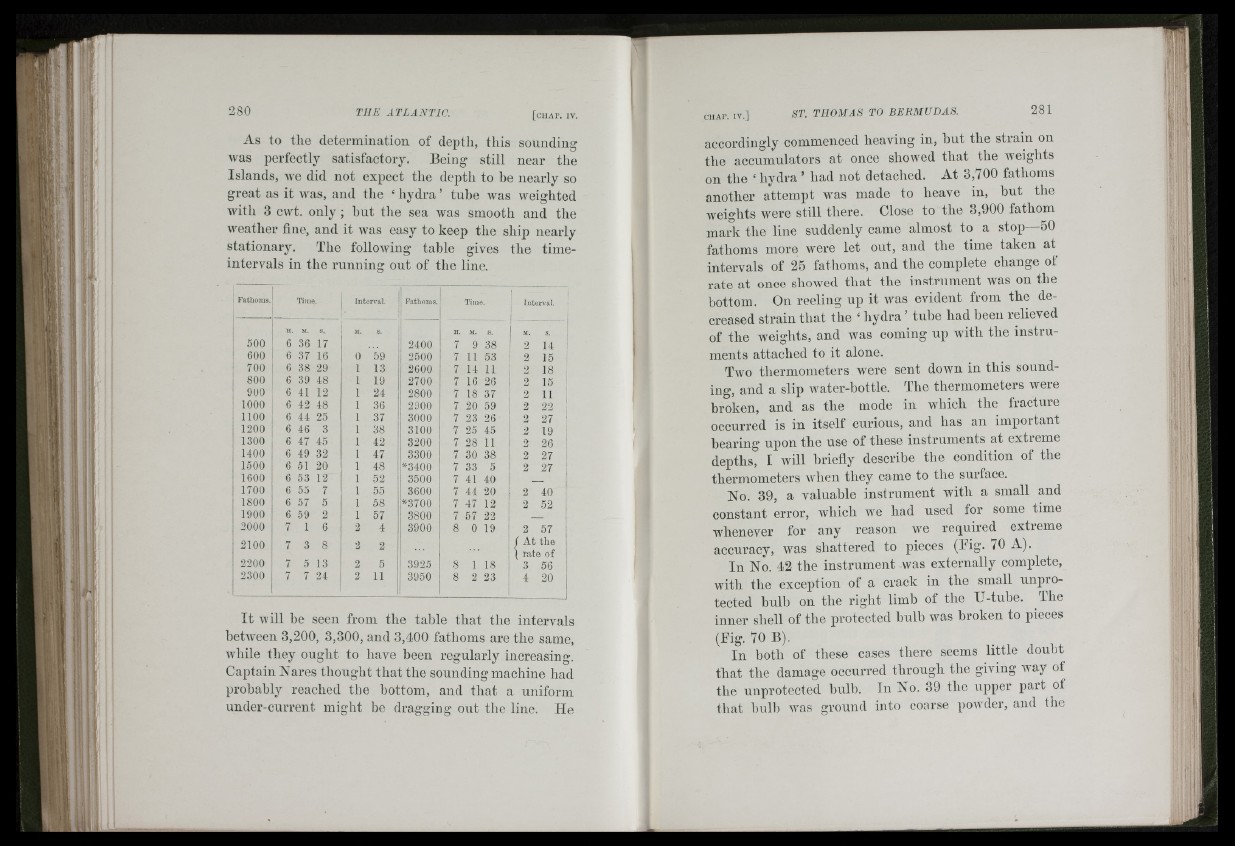
As to the determination of depth, this sounding
was perfectly satisfactory. Being still near the
Islands, we did not expect the depth to be nearly so
great as it was, and the ‘ hydra ’ tube was weighted
Avith 3 cwt. only ; hut the sea was smooth and the
AA'eather line, and it Avas easy to keep the ship nearly
stationary. The folioAving table gives the time-
intervals in the running out of the line.
F a th om s. Time. 1 In te rv a l. F a th om s. Time. ! In te rv a l.
H. M. i M. s. H. M. S. ! M. S.
500 6 36 17 2400 7 9 38 2 14
600 6 37 16 0 ” 59 2500 7 11 53 2 15
700 6 38 29 1 13 2600 7 14 11 2 18
800 6 39 48 1 19 2700 7 16 26 2 15
900 6 41 12 1 24 2800 7 18 37 2 11
1000 6 42 48 1 36 2900 7 20 59 2 22
1100 6 44 25 1 37 3000 7 23 26 2 27
1200 6 46 3 1 38 3100 7 25 45 2 19
1300 6 47 45 1 42 3200 7 28 11 2 26
1400 6 49 32 1 47 3300 7 30 38 2 27
1500 6 51 20 1 48 *3400 7 33 5 ! 2 27
1600 6 53 12 1 52 3500 7 41 40
1i
1700 6 55 7 1 55 3600 7 44 20 2 40
1800 6 57 5 1 58 *3700 7 47 12 2 52
1900 6 69 2 1 57 3800 7 57 22
2000 7 1 6 2 4 3900 8 0 19 2 57
2100 7 3 8 2 2 [ At the
1 rate of
2200 7 5 13 2 5 3925 8 1 18 3 56
2300 7 7 24 2 11 3950 8 2 23 4 20
It Avill be seen from the table that the intervals
betAveen 3,200, 3,300, and 3,400 fathoms are the same,
Avhile they ought to have been regularly increasing.
Captain Nares thought that the sounding machine had
probably reached the hottom, and that a uniform
under-current might be dragging out the line. He
S: t II
: H i/
CHAP. IV .]
accordingly commenced heaving in, hut the strain on
the accumulators at once showed that the aveights
on the ‘ hydra ’ had not detached. At 3,700 fathoms
another attempt was made to heave in, hut the
weights were still there. Close to the 3,900 fathom
mark the line suddenly came almost to a stop—50
fathoms more were let out, and the time taken at
intervals of 25 fathoms, and the complete change ot
rate at once showed that the instrument was on the
bottom. On reeling up it Avas evident from the decreased
strain that the ‘ hydra ’ tube had heen relieved
of the weights, and Avas coming up with the instruments
attached to it alone.
Two thermometers were sent doAvn in this sounding,
and a slip water-hottle. The thermometers were
broken, and as the mode in which the fracture
occurred is in itself curious, and has an important
bearing npon the use of these instruments at extreme
depths, I will briefly describe the condition of the
thermometers Avhen they came to the surface.
No. 39, a valuable instrument with a small and
constant error, which we had used for some time
whenever for any reason Ave required extreme
accuracy, was shattered to pieces (Eig. 70 A).
In No. 42 the instrument was externally complete,
with the exception of a crack in the small unprotected
hnlb on the right limb of the U-tnbe. The
inner shell of the protected bulb Avas broken to pieces
(Fig. 70 B).
In both of these cases there seems little douht
that the damage occurred through the giving AAay of
the unprotected bulb. In No. 39 the upper part of
tliat hull) was ground into coarse poAvder, and the
m
It
fi!
iiii'
I I
J